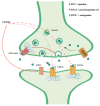Chronic Cocaine Use and Parkinson's Disease: An Interpretative Model
- PMID: 39200714
- PMCID: PMC11354226
- DOI: 10.3390/ijerph21081105
Chronic Cocaine Use and Parkinson's Disease: An Interpretative Model
Abstract
Over the years, the growing "epidemic" spread of cocaine use represents a crucial public health and social problem worldwide. According to the 2023 World Drug Report, 0.4% of the world's population aged 15 to 64 report using cocaine; this number corresponds to approximately 24.6 million cocaine users worldwide and approximately 1 million subjects with cocaine use disorder (CUD). While we specifically know the short-term side effects induced by cocaine, unfortunately, we currently do not have exhaustive information about the medium/long-term side effects of the substance on the body. The scientific literature progressively highlights that the chronic use of cocaine is related to an increase in cardio- and cerebrovascular risk and probably to a greater incidence of psychomotor symptoms and neurodegenerative processes. Several studies have highlighted an increased risk of antipsychotic-induced extrapyramidal symptoms (EPSs) in patients with psychotic spectrum disorders comorbid with psychostimulant abuse. EPSs include movement dysfunction such as dystonia, akathisia, tardive dyskinesia, and characteristic symptoms of Parkinsonism such as rigidity, bradykinesia, and tremor. In the present paper, we propose a model of interpretation of the neurobiological mechanisms underlying the hypothesized increased vulnerability in chronic cocaine abusers to neurodegenerative disorders with psychomotor symptoms. Specifically, we supposed that the chronic administration of cocaine produces significant neurobiological changes, causing a complex dysregulation of various neurotransmitter systems, mainly affecting subcortical structures and the dopaminergic pathways. We believe that a better understanding of these cellular and molecular mechanisms involved in cocaine-induced neuropsychotoxicity may have helpful clinical implications and provide targets for therapeutic intervention.
Keywords: Parkinsonism; Parkinson’s disease; cocaine; cocaine addiction; extrapyramidal symptoms.
Conflict of interest statement
The authors declare no conflicts of interest.
Figures





Similar articles
-
Psychomotor Symptoms in Chronic Cocaine Users: An Interpretative Model.Int J Environ Res Public Health. 2022 Feb 8;19(3):1897. doi: 10.3390/ijerph19031897. Int J Environ Res Public Health. 2022. PMID: 35162918 Free PMC article.
-
Cocaine-induced Movement Disorder: A Literature Review.Prague Med Rep. 2024;125(3):195-219. doi: 10.14712/23362936.2024.19. Prague Med Rep. 2024. PMID: 39171548 Review.
-
Characteristics of Patients Experiencing Extrapyramidal Symptoms or Other Movement Disorders Related to Dopamine Receptor Blocking Agent Therapy.J Clin Psychopharmacol. 2019 Jul/Aug;39(4):336-343. doi: 10.1097/JCP.0000000000001061. J Clin Psychopharmacol. 2019. PMID: 31205194 Free PMC article.
-
Cocaine is a major risk factor for antipsychotic induced akathisia, parkinsonism and dyskinesia.Psychopharmacol Bull. 2008;41(3):5-10. Psychopharmacol Bull. 2008. PMID: 18779773
-
[Prevention and treatment of tardive dyskinesia caused by antipsychotic drugs].Encephale. 2016 Jun;42(3):248-54. doi: 10.1016/j.encep.2015.12.021. Epub 2016 Feb 26. Encephale. 2016. PMID: 26922134 Review. French.
Cited by
-
Global and regional burden of four drug use disorders in the elderly, 1990 to 2021: an analysis of the global burden of disease study.BMC Geriatr. 2025 Jul 2;25(1):434. doi: 10.1186/s12877-025-06075-5. BMC Geriatr. 2025. PMID: 40604442 Free PMC article.
References
-
- United Nations Office on Drugs and Crime . World Drug Report 2023. United Nations Publication; New York, NY, USA: 2023.
-
- Blum K., Braverman E.R., Holder J.M., Lubar J.F., Monastra V.J., Miller D., Lubar J.O., Chen T.J., Comings D.E. Reward deficiency syndrome: A biogenetic model for the diagnosis and treatment of impulsive, addictive, and compulsive behaviors. J. Psychoact. Drugs. 2000;32((Suppl. 1)):1–112. doi: 10.1080/02791072.2000.10736099. - DOI - PubMed
-
- Blum K., Kozlowski G.P. Ethanol and Neuromodulator Interactions: A Cascade Model of Reward. In: Ollat H., Parvez S., Parvez H., editors. Alcohol and Behavior. VSP Press; Utrecht, The Netherlands: 1990. pp. 131–149.
MeSH terms
Substances
LinkOut - more resources
Full Text Sources
Medical

